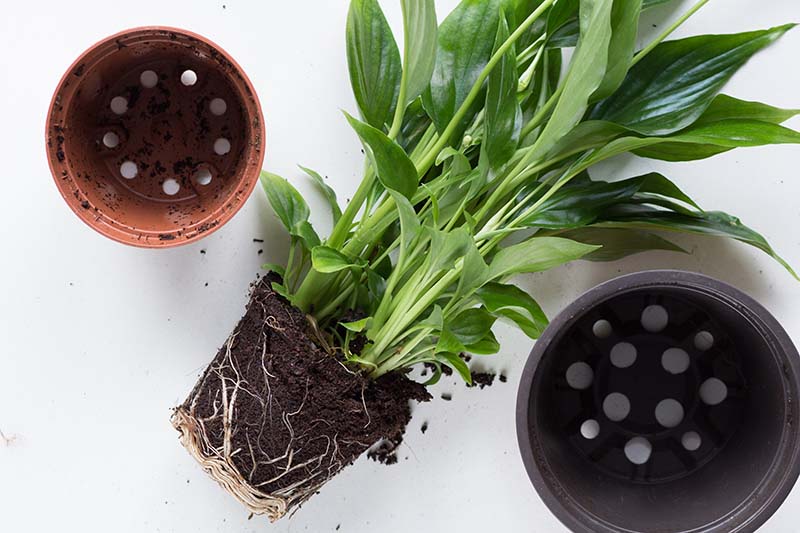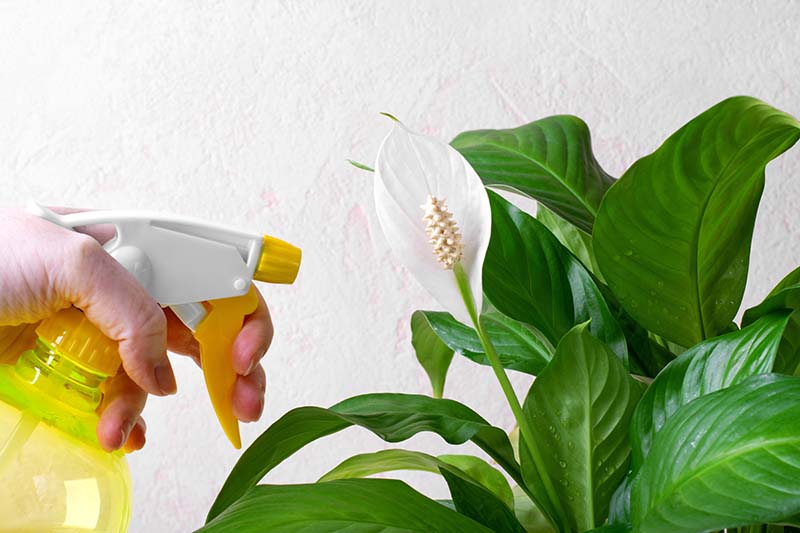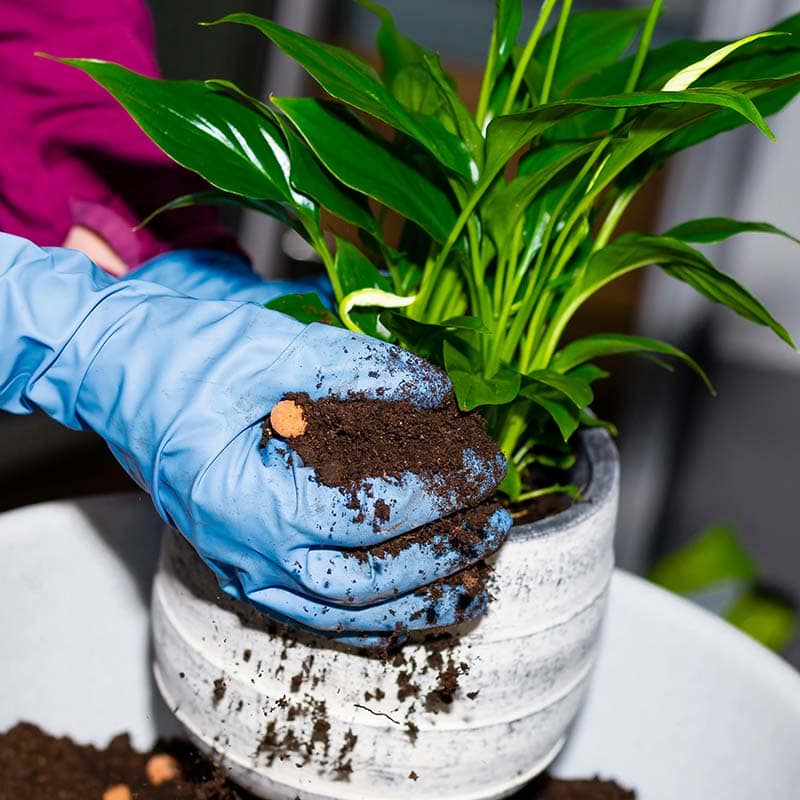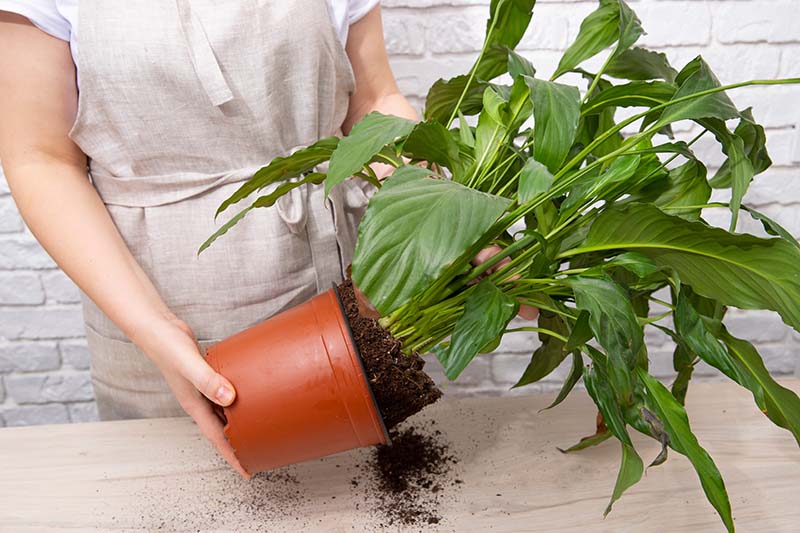Do Peace Lilies Like to Be Root Bound? 5 Repotting Tips
-
Pete Ortiz
- Last updated:

Since 2019, the number of people with houseplants has increased to 66%.1 This increase is due to the various benefits of houseplants, such as better mental healthcare, improved physical well-being, and better house appearance. However, to enjoy these benefits, you’re required to take care of these plants based on the variety you have. For instance, peace lilies like to be root bound and are therefore easy to care for.
Houseplants become root bound when they grow to the extent that their roots become entangled and congested in pots. Because peace lilies enjoy being root bound, you don’t have to repot them to bigger pots until they show poor growth signs.
This article explains why peace lilies like to be root bound and provides signs that indicate you need to repot them. Continue reading to learn more.
Why Do Peace Lilies Like to Be Root Bound?
For peace lilies (Spathiphyllum), being root bound has various benefits, as seen below:
1. They Absorb Water Fast
One way you can care for your peace lilies is by watering them, as they do not survive in dry soil. However, too much water leads to root rot. According to Planterhoma, the best way to water your peace lilies is to place them in a sink and let the water drip into the plants until it starts dripping through the pot’s bottom or drainage holes.2
Since bounded roots are in a smaller space, there is a high water concentration in the soil when you water your peace lilies. As a result, all the root hairs get enough water, absorb it faster, and transport it to the stems and leaves for photosynthesis.
Besides the fast water absorption, peace lilies contain more moisture when they have bounded roots. Unlike spread-out roots, constrained roots hold onto soil moisture longer, allowing them to stay hydrated for longer.

2. They Grow Stronger
Peace lilies have delicate roots and can easily get damaged when repotted often. Therefore, when a peace lily becomes root bound, its roots become packed tightly together, which increases the plant’s support. The increased structure support restricts the plant’s movement, which in turn helps increase moisture and nutrient absorption from the soil. As a result, your plant lilies undergo healthy growth.
Moreover, the contained environment of the roots helps the lilies to concentrate their energy on growing upwards instead of outwards. When peace lilies’ roots are too spread out, the plants become top-heavy and can be unstable. Therefore, they can easily topple over. However, they will grow taller, healthier, and bloom more when they are root bound.
3. They Maintain Constant Temperature
For better growth of your plant, there is a need to keep the temperature constant; too high or low temperatures often reduce photosynthesis.3
A peace lily can have difficulty controlling its temperature in a large container due to the fluctuating soil temperature. On the other hand, if the same plant is in a container where its roots are confined, it regulates its temperature better, thus allowing it to withstand changing temperatures.
However, despite these positive reasons stated above, you may sometimes be forced to repot your peace lilies. How can you know it is time to repot your peace lilies?

The 4 Signs You Need to Repot Your Peace Lily
Here are some of the signs that indicate you need to repot your peace lily:
1. Roots Are Growing Outside the Pot or Container
After a while, the roots of a peace lily may have no space to grow to. As a result, they will look for spaces, such as drainage holes, where they can penetrate through. When you notice such signs, it indicates that your plants have outgrown their current pot’s space and need larger pots. That is because, under such conditions, peace lilies will stop receiving enough water and nutrients, which can result in their death.
2. The Soil Dries Up Quickly
At times, there may be no physical signs of protruding roots that tell you it is time for repotting. However, you may notice that your plant’s soil is drying up faster every time you water them. This means that less water is being held on. That can result from the overcrowded roots taking up the soil’s space.
Another reason that could explain the quick drying up is a decrease in the soil’s quality, which happens when you use the same soil for a long time.
When the roots take up too much space, they prevent a high water concentration, limiting the amount of water or moisture the soil can retain. In the end, your peace lily dries up faster.

3. The Leaves Turn Yellow or Brown
Another sign that shows that you need to repot your peace lily is yellow or brown leaves. As stated above, when peace lilies’ roots have overgrown, they take up a lot of space, thus reducing the amount of water retained. When that happens, peace lilies’ leaves may turn yellow or brown because they are getting minimal water. Leaves begin to change color from the tips and edges. They also become crispy.
Apart from water deficiency, lack of enough nutrients can also cause the change in leaves’ color.
4. Your Peace Lily Stops Growing
How a plant grows partially depends on its root growth. If the roots stop growing or grow slowly, the plant’s growth will also be slow. That is the same case with peace lilies. When their roots are bound, they stop growing fast because of the limited space in the pots or containers, which contributes to limited water as well as nutrients.
Apart from the slow growth, the leaves of a peace lily that is root bound are usually smaller than those in the fields.
Further, it is essential to note that there are other factors that affect the growth of a peace lily that is root bound. For instance, if your peace lily gets less than six hours of indirect sunlight in a day or minimal fertilizer, then high chances are it will stop growing or grow slowly.
If you notice any of the above four signs in your peace lily, consider repotting it as soon as possible. Further, remember that how you repot determines whether your peace lilies will survive. That leads to the question, “How do you repot peace lilies?”
How to Repot Peace Lilies in 5 Steps
Use these steps as a guide when repotting peace lilies:
1. Choosing a Bigger Pot or Container
Since the main purpose of repotting is to find a pot that has more space, look for a pot that is one or two inches bigger than the current pot. That will ensure that your plant’s roots have adequate space for growth and are not too big to interfere with how they control their temperature and focus their energy on their growth.
2. Remove Your Peace Lilies From Their Containers
When removing your peace lilies from their current containers, do it gently and carefully to prevent the roots from being damaged. If the roots are tightly bound such that they cannot come out as a ball, you can use a sharp knife to divide the root ball into two halves.

3. Prune Damaged or Dead Roots
Before you place your plants into new containers, look for any old or damaged roots and trim them off. For instance, you can use a sharp knife or shears to trim those roots that appear to be growing in a circular pattern. Trimming helps in ensuring that you only repot healthy parts of your plants.
4. Proceed to Place Your Plants in Their New Containers
After you get rid of the damaged or dead roots, place your peace lilies in their new pots. After that, fill the new pots with fresh and well-drained soil to a point where all the roots are covered. Moreover, ensure that the amount of soil you add is enough to support your peace lilies so they do not tip over.
5. Water Your Peace Lilies and Place Them in a Convenient Location
After transplanting and firming the soil, add enough water to the plants. In this step, do not limit the amount of water you use. Instead, use a lot of it and allow the excess water to drain from the pot’s bottom. Watering your plants helps ease the transplant shock and settle the soil.
A convenient place to position the new pots is where the peace lilies will receive enough indirect sunlight with moderate temperature. You can set up a plant room or use one side of your house.
Conclusion
As seen, peace lilies like to be root bound, and for a good reason. First, it helps in better water retention, temperature regulation, and stronger growth. However, being excessively root bound may have some disadvantages, such as the soil drying up quickly, leaves turning yellow or even the plant dying up because of a lack of nutrients.
So, at some point, your peace lily will need a bigger space to accommodate its growth. You will need to repot it to cater to this need. Just ensure that you don’t repot to a container too big to deny the plant a chance of being root bound.
- The number of households with houseplants has increased to 66% from 2019
- Direct sunlight can scorch the foliage of your peace lilies
- Lack of enough water and fertilizer can cause peace lilies to turn yellow
- Signs you need to repot your peace lilies
- Steps used when repotting peace lilies
- Why peace lilies like to be root bound
Featured Image Credit: Tatiana Foxy, Shutterstock
Contents


